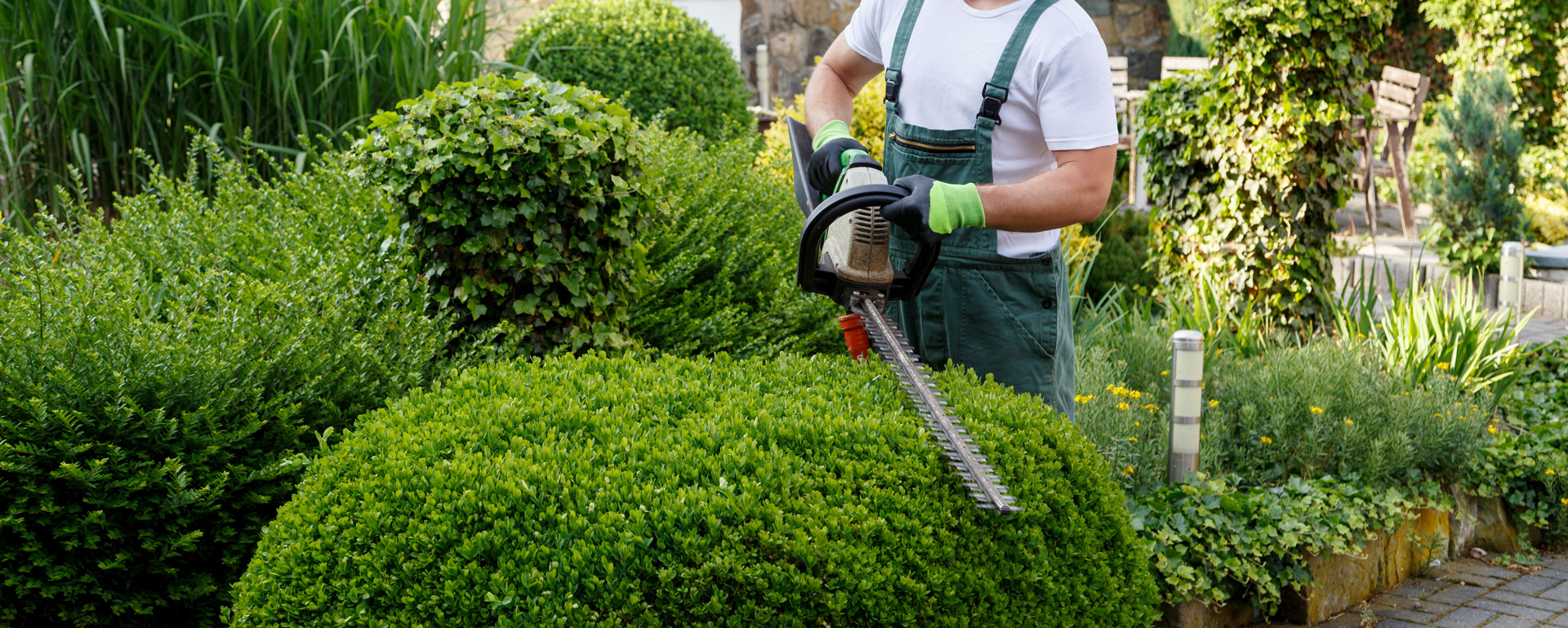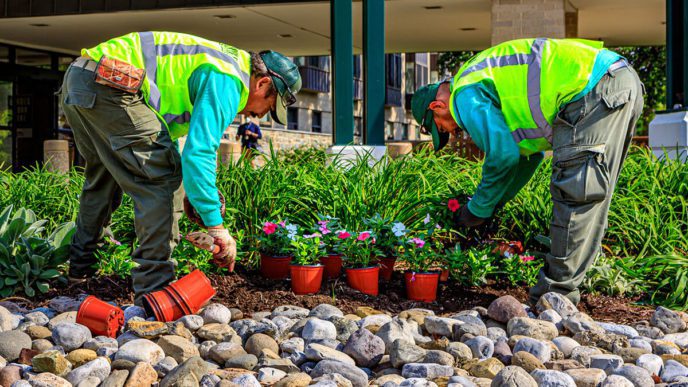Discover ways professional landscaping services can transform your outdoor space
Wiki Article
Understanding the Comprehensive Scope of Functions in Specialist Landscape Design Services
The comprehensive scope of professional landscaping services encompasses a range of basic components - landscaping services. It consists of landscape style principles, plant option, and hardscaping features. Additionally, it attends to watering systems and upkeep techniques. Each element plays an important role in creating useful and cosmetically pleasing outdoor rooms. Understanding how these elements collaborate can expose much about the art and scientific research of landscape design. Nevertheless, the journey into this intricate field is just startingLandscape Style Concepts
Reliable landscape style concepts are essential for developing harmonious outdoor spaces that boost both aesthetic allure and performance (Learn More). These principles lead the arrangement of aspects within the landscape, ensuring a cohesive visual experience. Key components consist of balance, which distributes aesthetic weight equally; proportion, which connects the size of numerous components per other and the space; and unity, which creates a sense of wholeness through regular themes and materials
Plant Option and Setup
In the domain name of expert landscape design, plant option and installation play a vital role in accomplishing a prospering yard. Emphasizing native plant benefits, seasonal considerations, and the certain soil and sunshine requirements of each species assures a sustainable and aesthetically pleasing landscape. Mindful planning in these areas not just improves biodiversity however likewise promotes lasting eco-friendly wellness.Indigenous Plant Advantages
Why should homeowners think about indigenous plants for their landscape design jobs? Native plants use many advantages that improve both visual appeals and ecological sustainability. They are well-adapted to regional climates, calling for much less water and upkeep contrasted to non-native species. This strength minimizes the demand for chemical plant foods and pesticides, promoting a much healthier ecosystem. In addition, native plants provide habitat and food for neighborhood wildlife, including pollinators, which can boost biodiversity in houses. Their familiarity with local soil and climate condition likewise causes much better growth prices and durability. By choosing native plants, homeowners not only create visually enticing landscapes however likewise add to ecological preservation, making a favorable effect on their neighborhood setting. Native plants represent a clever option for landscaping tasks.Seasonal Plant Considerations
Homeowners who have actually accepted indigenous plants in their landscaping can additionally boost their exterior spaces by considering seasonal plant selections. By integrating plants that prosper in certain periods, they can develop dynamic and aesthetically attractive landscapes throughout the year. Spring might introduce lively flowers like tulips and daffodils, while summer can showcase lavish foliage and vivid perennials. Fall introduces a combination of warm tones with asters and goldenrods, while winter months can be emphasized with evergreens and ornamental turfs for texture. Specialist landscapers frequently suggest choosing plants that not only complement existing indigenous varieties yet additionally give year-round rate of interest and support local wild animals. This thoughtful approach to seasonal plant choice guarantees a constantly developing and sustainable garden setting.Soil and Sunlight Requirements
Effective landscaping rests on comprehending the specific dirt and sunlight needs of plants. Various species prosper under varying problems, needing a careful analysis of both variables during the choice procedure. Soil types, such as sandy, clay, or fertile, impact drainage, vitamins and mineral accessibility, and root advancement. Additionally, pH levels can influence plant wellness, requiring soil screening to ascertain suitability. Sunshine needs vary substantially; some plants flourish completely sunlight, while others choose partial or full shade. An expert landscaper takes into consideration these elements to assure peak growth and aesthetic allure. By lining up plant choices with the environment's certain attributes, landscapes can achieve sustainability, strength, and aesthetic consistency, eventually bring about successful plant facility and long-lasting upkeep.Hardscaping Attributes and Construction

While landscape design usually stimulates pictures of rich greenery and dynamic flowers, hardscaping functions play a crucial role in defining exterior rooms. These aspects, which consist of patios, pathways, keeping walls, and ornamental stonework, provide structure and performance to backyards and gardens. Hardscaping utilizes materials such as concrete, stone, brick, and timber, allowing for diverse layouts that complement the natural landscape.
The construction of hardscaping features calls for cautious planning and implementation to ensure sturdiness and aesthetic allure. Professionals assess site problems, drainage, and spatial partnerships to create natural exterior environments. Correct setup techniques are crucial, as they prevent issues like erosion and moving over time.
Integrating hardscaping not just improves the visual interest of a property yet additionally helps with exterior tasks, making it an essential aspect of detailed landscaping services. Eventually, thoughtful hardscaping adds to both the performance and elegance of exterior spaces.
Irrigation Solutions and Water Management
Efficient irrigation systems and water monitoring are vital parts of expert landscape design, as they guarantee that plants receive the necessary hydration for ideal growth. These systems can vary from basic drip watering arrangements to advanced computerized lawn sprinkler, designed to fulfill the specific needs of diverse landscapes. Appropriate water monitoring not only enhances water use, minimizing waste, but likewise improves plant health and wellness and reduces disease risks.Landscape design specialists analyze numerous elements, including dirt kind, plant species, and local environment, to create customized irrigation options. Additionally, incorporating rainwater harvesting techniques can better boost sustainability and effectiveness. Normal maintenance of watering systems is necessary to keep functionality and protect against leaks, which can result in water loss and raised prices (Learn More). Eventually, a well-designed watering system plays an essential duty in preserving the aesthetic charm of outside areas while advertising ecological stewardship within expert landscape design techniques
Yard Treatment and Maintenance Approaches
Lawn treatment and upkeep techniques are basic for accomplishing a rich, healthy yard that enhances the general landscape. These approaches encompass various practices focused on advertising suitable growth and visual charm. Routine mowing is necessary, as it motivates thick, also development while avoiding weeds from establishing. In addition, appropriate fertilizing provides essential nutrients, with applications tailored to the details lawn type and soil problems.Watering techniques need to focus on deep, occasional watering to motivate root development, while aeration boosts soil structure and promotes nutrient absorption. Pest and illness administration is likewise important; identifying issues early enables efficient therapies that minimize damages.
Overseeding can renew slim or broken yards, enhancing density and color (landscaping). By executing these targeted yard treatment approaches, landscaping professionals can guarantee that yards continue to be dynamic and healthy and balanced throughout the periods, considerably adding to the total appeal of the home
Seasonal Landscape Treatment and Upkeep
As the seasons adjustment, correct landscape care comes to be essential for maintaining the health and beauty of exterior spaces. Each period presents unique obstacles and demands. In springtime, landscape specialists concentrate on trimming, growing, and fertilizing to encourage growth. Summer demands regular watering, weed control, and insect management to protect recently established plants.
Throughout the year, seasonal landscape upkeep guarantees that exterior locations continue to be healthy and visually attractive. Specialist services can offer tailored upkeep strategies that adjust to the specific demands of each period, enabling residential property owners to delight in lively landscapes year-round. Generally, seasonal treatment is an important facet of professional landscaping that promotes longevity and visual worth.

Lasting Landscape Design Practices
An expanding variety of property proprietors are welcoming sustainable landscape design techniques to develop ecologically friendly outdoor areas. These methods focus on conserving sources, boosting biodiversity, and reducing environmental impact. Indigenous plants are commonly chosen for their reduced water requirements and compatibility with regional environments, reducing the need for chemical fertilizers and pesticides. Rainfall gardens and permeable paving are employed to manage stormwater drainage, advertising groundwater recharge and lowering disintegration.In addition, sustainable landscape design integrates natural gardening strategies that focus on soil health and wellness and promote all-natural parasite control. Efficient watering systems, such as drip irrigation and rain harvesting, assistance enhance water usage. In addition, landscape designers increasingly promote for making use of recycled materials, such as redeemed timber and rocks, to minimize waste. By adopting these lasting methods, homeowner not just contribute to ecological preservation however also develop visually pleasing atmospheres that can flourish with very little upkeep.
Regularly Asked Questions
Just how Long Does a Landscape Design Job Usually Require To Full?
Normally, a landscaping project can take anywhere from a few days to numerous weeks to finish, depending upon the project's dimension, complexity, and design requirements. Variables such as weather and resource schedule additionally affect timelines.What Elements Influence the Expense of Landscape Design Services?
Different aspects affect landscape design solution costs, consisting of project size, style complexity, material high quality, labor costs, geographic location, and seasonal need. Each aspect adds distinctly to the total monetary requirements of a landscape design task.
Are Landscaping Provider Available Year-Round?
Landscape design services are normally available year-round, although accessibility may vary based upon area, seasonal weather, and details service offerings. Some services could be limited throughout extreme weather condition or off-peak periods.Do Landscape Design Companies Offer Service Warranties on Their Job?
Many landscape design companies do supply warranties on their work, which can differ in size and protection. Customers are encouraged to ask about particular terms, guaranteeing they recognize what is ensured and any conditions that apply.Can I Design My Landscape Without Expert Help?
Yes, individuals can make their landscapes without expert aid. Nonetheless, they may do not have knowledge in plant selection, layout, and environmental factors to consider, potentially resulting in less efficient layouts that can call for expensive changes later.In the domain of specialist landscaping, plant selection and installation play a critical function in accomplishing a prospering yard. Homeowners that have actually accepted indigenous plants in their landscaping can better boost their exterior areas by considering seasonal plant choices. Effective landscape design hinges click here on recognizing the specific dirt and sunlight needs of plants. Reliable irrigation systems and water monitoring are vital parts of expert landscape design, as they ensure that plants receive the necessary hydration for optimal growth. Landscaping specialists examine numerous aspects, including dirt type, plant types, and local climate, to develop customized irrigation solutions.
Report this wiki page